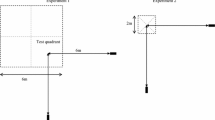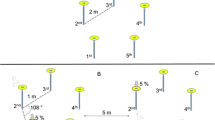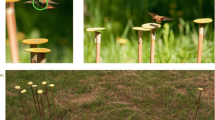Abstract
Beaconing to rewarded locations is typically achieved by visual recognition of the actual goal. Spatial recognition, on the other hand, can occur in the absence of the goal itself, relying instead on the landmarks surrounding the goal location. Although the duration or frequency of experiences that an animal needs to learn the landmarks surrounding a goal have been extensively studied with a variety of laboratory tasks, little is known about the way in which wild vertebrates use them in their natural environment. Here, we allowed hummingbirds to feed once only from a rewarding flower (goal) before it was removed. When we presented a similar flower at a different height in another location, birds frequently returned to the location the flower had previously occupied (spatial recognition) before flying to the flower itself (beaconing). After experiencing three rewarded flowers, each in a different location, they were more likely to beacon to the current visible flower than they were to return to previously rewarded locations (without a visible flower). These data show that hummingbirds can encode a rewarded location on the basis of the surrounding landmarks after a single visit. After multiple goal location manipulations, however, the birds changed their strategy to beaconing presumably because they had learned that the flower itself reliably signalled reward.





Similar content being viewed by others
References
Babb SJ, Crystal JD (2006) Episodic-like memory in the rat. Curr Biol 16:1317–1321
Bast T, Da Silva BM, Morris RGM (2005) Distinct contributions of hippocampal NMDA and AMPA receptors to encoding and retrieval of one-trial place memory. J Neurosci 25:5845–5856
Bjork RA, Whitten WB (1974) Recency-sensitive retrieval processes in long-term free recall. Cognitive Psychol 6:173–189
Brodbeck DR, Burack OR, Shettleworth SJ (1992) One-trial associative memory in black-capped chickadees. J Exp Psychol Anim Behav Process 18:12–21
Castro CA, Larsen T (1992) Primacy and recency effects in nonhuman primates. J Exp Psychol Anim Behav Process 18:335–340
Clayton NS, Dickinson A (1998) Episodic-like memory during cache recovery by scrub jays. Nature 395:272–274
Clayton NS, Dickinson A (1999) Scrub Jays (Aphelocoma coerulescens) remember the relative time of caching as well as the location and content of their caches. J Comp Psychol 113:403–416
Clayton NS, Krebs JR (1994) One-trial associative memory: comparison of food-storing and non-storing species of bird. Anim Learn Behav 22:366–372
Clayton NS, Bussey TJ, Dickinson A (2003a) Can animals recall the past and plan for the future? Nat Rev Neurosci 4:685–691
Clayton NS, Yu KS, Dickinson A (2003b) Interacting cache memories: evidence for flexible memory use by Western Scrub-Jays (Aphelocoma californica). J Exp Psychol Anim Behav Process 29:14–22
Collett TS, Graham P (2004) Animal navigation: path integration, visual landmarks and cognitive maps. Curr Biol 14:475–478
Crystal JD (2010) Episodic-like memory in animals. Behav Brain Res 215:235–243
Crystal JD, Shettleworth SJ (1994) Spatial list learning in black-capped chickadees. Anim Learn Behav 22:77–83
Day M, Langston R, Morris RGM (2003) Glutamate-receptor-mediated encoding and retrieval of paired-associate learning. Nature 424:205–209
Dere E, Kart-Teke E, Huston JP, De Souza Silva MA (2006) The case for episodic memory in animals. Neurosci Biobehav Rev 30:1206–1224
Devan BD, White NM (1999) Parallel information processing in the dorsal striatum: relation to hippocampal function. J Neurosci 19:2789–2798
Doeller CF, King JA, Burgess N (2008) Parallel striatal and hippocampal systems for landmarks and boundaries in spatial memory. P Natl Acad Sci-Biol 105:5915–5920
Eacott MJ, Easton A (2007) On familiarity and recall of events by rats. Hippocampus 17:890–897
Eacott MJ, Easton A, Zinkivskay A (2005) Recollection in an episodic-like memory task in the rat. Learn Memory 12:221–223
Fukushi T, Wehner R (2004) Navigation in wood ants Formica japonica: context dependent use of landmarks. J Exp Biol 207:3431–3439
Gill FB (1988) Trapline foraging by Hermit hummingbirds: competition for an undefended, renewable resource. Ecology 69:1933–1942
Gould KL, Kelly DM, Kamil AC (2010) What scatter-hoarding animals have taught us about small-scale navigation. Phil Trans R Soc B 365:901–914
Graham P, Fauria K, Collett TS (2003) The influence of beacon-aiming on the routes of wood ants. J Exp Biol 206:535–541
Healy S, Hurly TA (1995) Spatial memory in rufous hummingbirds (Selasphorus rufus): a field test. Anim Learn Behav 23:63–68
Healy SD, Hurly TA (1998) Rufous hummingbirds’ (Selasphorus rufus) memory for flowers: patterns or actual spatial locations? J Exp Psychol Anim Behav Process 24:396–404
Healy SD, Hurly TA (2003) Cognitive ecology: foraging in hummingbirds as a model system. Adv Stud Behav 32:325–359
Healy SD, Krebs JR (1992) Comparing spatial memory in two species of tit: recalling a single positive location. Anim Learn Behav 20:121–126
Henderson J, Hurly TA, Healy SD (2001) Rufous hummingbirds’ memory for flowers. Anim Behav 61:981–986
Henderson J, Hurly T, Healy S (2006) Spatial relational learning in rufous hummingbirds (Selasphorus rufus). Anim Cogn 9:201–205
Hurly TA, Healy SD (1996) Memory for flowers in rufous hummingbirds: location or local visual cues? Anim Behav 51:1149–2257
Hurly TA, Healy SD (2002) Cue learning by rufous hummingbirds. J Exp Psychol Anim Behav Process 28:209–223
Hurly TA, Scott RD, Healy SD (2001) The function of displays of male rufous hummingbirds. Condor 103:647–651
Hurly TA, Franz S, Healy SD (2010) Do rufous hummingbirds (Selasphorus rufus) use visual beacons? Anim Cogn 13:377–383
Kelly D (2010) Features enhance the encoding of geometry. Anim Cogn 13:453–462
Kelly DM, Spetch ML (2004a) Reorientation in a two-dimensional environment: I. Do pigeons (Columba livia) encode the featural and geometric properties of a two-dimensional schematic of a room? J Comp Psychol 118:384–395
Kelly DM, Spetch ML (2004b) Reorientation in a two-dimensional environment: II. Do adults encode the featural and geometric properties of a two-dimensional schematic of a room? J Comp Psychol 118:82–94
Naqshbandi M, Roberts WA (2006) Anticipation of future events in squirrel monkeys (Saimiri sciureus) and rats (Rattus norvegicus): tests of the Bischof-Kohler hypothesis. J Comp Psychol 120:345–357
O’Keefe J, Nadel L (1978) The hippocampus as a cognitive map. Clarendon Press, Oxford
Pearce JM, Roberts ADL, Good M (1998) Hippocampal lesions disrupt navigation based on cognitive maps but not heading vectors. Nature 396:75–77
Pearce JM, Ward-Robinson J, Good M, Fussell C, Aydin A (2001) Influence of a beacon on spatial learning based on the shape of the test environment. J Exp Psychol Anim Behav Process 27:329–344
Pearce JM, Graham M, Good MA, Jones PM, McGregor A (2006) Potentiation, overshadowing, and blocking of spatial learning based on the shape of the environment. J Exp Psychol Anim Behav Process 32:201–214
Roberts WA, Feeney MC, Macpherson K, Petter M, Mcmillan N, Musolino E (2008) Episodic-like memory in rats: is it based on when or how long ago? Science 320:113–115
Steele R, Morris RGM (1999) Delay-dependent impairment of a matching-to-place task with chronic and intrahippocampal infusion of the NMDA-antagonist D-AP5. Hippocampus 9:118–136
Zinkivskay A, Nazir F, Smulders TV (2009) What-where-when memory in magpies (Pica pica). Anim Cogn 12:119–125
Acknowledgments
This research was supported by CONACYT (Consejo Nacional de Ciencia y Teconología), the University of Lethbridge and the Natural Sciences and Engineering Council of Canada. We thank Cam Finlay and Ida Bacon for support in the field and Rosamund Langston and three anonymous reviewers for comments on an earlier version of the manuscript.
Author information
Authors and Affiliations
Corresponding author
Rights and permissions
About this article
Cite this article
Flores-Abreu, I.N., Hurly, T.A. & Healy, S.D. One-trial spatial learning: wild hummingbirds relocate a reward after a single visit. Anim Cogn 15, 631–637 (2012). https://doi.org/10.1007/s10071-012-0491-0
Received:
Revised:
Accepted:
Published:
Issue Date:
DOI: https://doi.org/10.1007/s10071-012-0491-0




